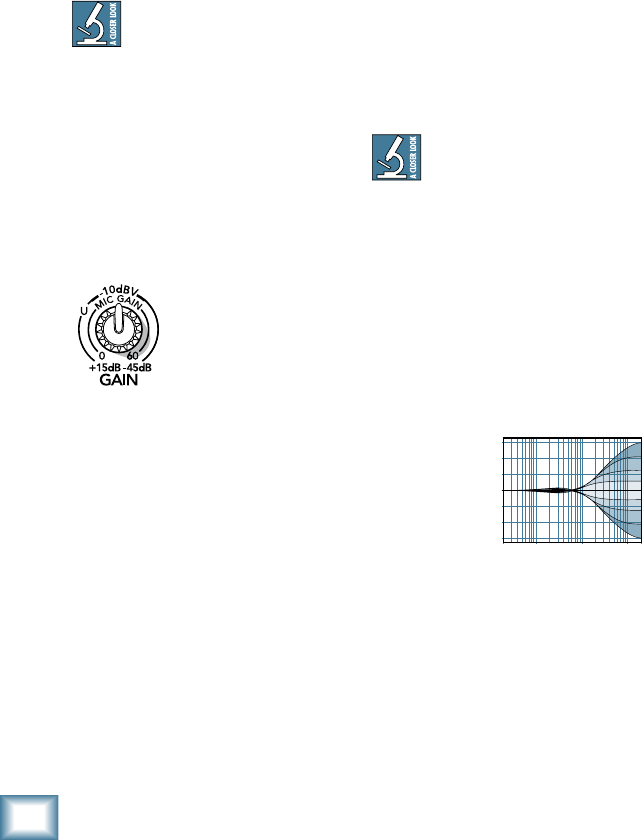
14
40-VLZ3
402-VLZ3
for “unity gain,” meaning no change in signal
level. Once you have adjusted the input
signal to line-level, you can set every control
at “U” and your signals will travel through
the mixer at optimal levels. What’s more, all
the labels on our level controls are measured
in decibels (dB), so you’ll know what you’re
doing level-wise if you choose to change a
control’s settings.
2-BAND EQUALIZATION
The 402-VLZ3 has 2-band equalization at
carefully selected points — low shelving at
80 Hz, and hi shelving at 12 kHz. “Shelving”
means that the circuitry boosts or cuts all
frequencies past the specified frequency.
For example, rotating the low EQ knob 15
dB to the right boosts bass starting at 80 Hz
and continuing down to the lowest note you
never heard.
With EQ, you can also screw things
up royally. We’ve designed a lot of
boost and cut into each equalizer
circuit, because we know everyone will
occasionally need that. But if you max the
EQs on every channel, you’ll get mix mush.
Equalize subtly and use the left sides of the
knobs (cut), as well as the right (boost).
Very few gold-record-album engineers ever
use more than about 3 dB of EQ. If you need
more than that, there’s usually a better way
to get it, such as placing a mic differently (or
using a different kind of mic entirely).
8. HI EQ
This control
gives you up to
15 dB boost or
cut above 12 kHz,
and it is also flat
at the center. Use
it to add sizzle
to cymbals, and
an overall sense of transparency, or edge to
keyboards, vocals, guitar and bacon frying.
Turn it down a little to reduce sibilance, or
to hide tape hiss.
9. LOW EQ
This control gives you up to 15 dB boost or
cut below 80 Hz. The circuit is flat (no boost
or cut) at the center position. This frequency
6. INSTRUMENT SWITCH (Ch.1–2)
When this switch is pressed in, chan-
nel 1 or 2's line input can accept direct
instrument-level signals from guitars or
other instruments. They will be impedance-
matched to the line input, without the need
for a DI box.
When this switch is out, you can connect
line-level sources such as CD players, MP3
players, keyboards, drum machines, and tape
players. You will need a DI box if connect-
ing instrument-level signals to the inputs of
channel 3 and 4.
Direct-In (DI) boxes are commonly
available from most music stores.
They provide signal and impedance
matching for the direct connection of guitars
and other instruments to amplifiers and
mixers. They convert unbalanced instru-
ment-level signals to a balanced mic-level
output. Normally, they just look like a funny
little box with a 1/4" TS input at one end,
and an XLR output at the other. The good
thing is that you do not need them with the
402-VLZ3.
7. LET'S TWIST A GAIN (Ch.1–2)
If you haven’t already,
please read the input level
adjustment procedure on
page 4.
Gain adjusts the input
sensitivity of the mic and
line inputs connected to channels 1 and 2.
This allows signals from the outside world
to be adjusted to optimal internal operating
levels.
If the signal comes through the XLR jack,
there will be 0 dB of gain with the knob fully
down, ramping to 60 dB of gain fully up.
Through the 1⁄4" input, there is 15 dB of
attenuation fully down and 45 dB of gain
fully up, with a “U” (unity gain) mark at
10:00. This 15 dB of attenuation can be very
handy when you are inserting a very hot
signal, or when you want to add a lot of EQ
gain, or both. Without this “virtual pad,” this
scenario might lead to channel clipping.
“U” LIKE UNITY GAIN
Mackie mixers have a “U” symbol on
almost every level control. This “U” stands
20
Hz
100
Hz
1k
Hz
10k
Hz
20k
Hz
–15
–10
–5
0
+5
+10
+15
High EQ


















